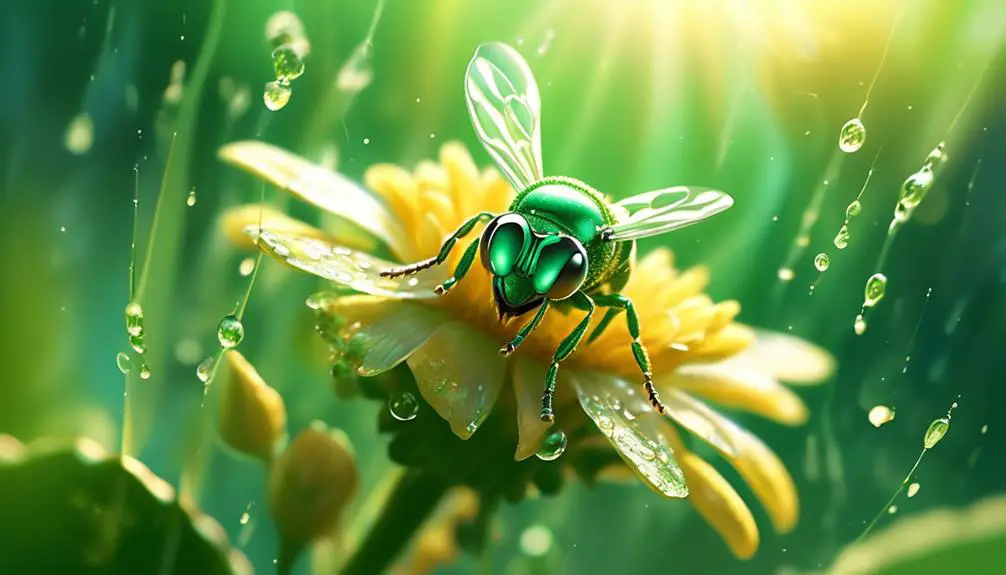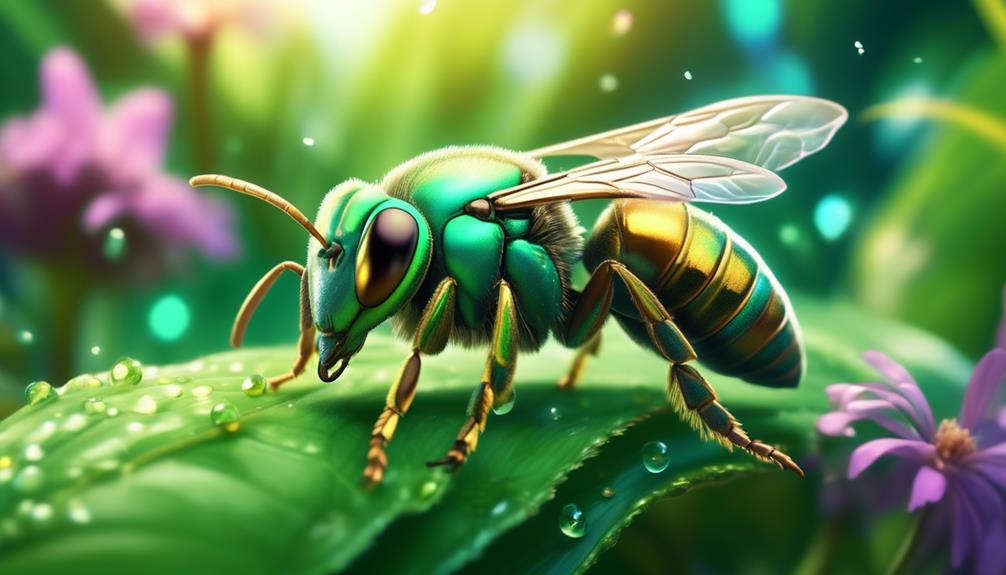Crack the code of sweat bees' true identity and uncover why these tiny creatures are more than their common name suggests.

What Are Sweat Bees Really Called
You know what they say, 'A rose by any other name would smell as sweet,' but when it comes to sweat bees, their name might not be quite as charming as their diminutive size. Known for their attraction to human perspiration, sweat bees are often associated with summertime buzzing and unexpected stings.
But did you know that 'sweat bee' is merely a common name, and these little insects carry a more scientific moniker? Stick around and we'll unravel the mystery behind the true identity of these fascinating creatures.
Key Takeaways
- Sweat bees belong to the family Halictidae and are part of the order Hymenoptera.
- Sweat bees are attracted to human perspiration due to the salts and electrolytes it contains.
- They are important pollinators for wildflowers and crops.
- Sweat bees play a significant role in the ecosystem and their populations can be supported through natural gardening practices.
Understanding the Sweat Bee Phenomenon

To truly grasp the phenomenon of sweat bees, it's crucial to delve into their unique biology, behavior, and their intriguing adaptations to the human environment. You see, sweat bees, or Halictidae, aren't your typical bees. They're small, often metallic, and they're attracted to your perspiration, thus the name. But why your sweat? It's not just to annoy you. No, these bees crave the salts and electrolytes in your sweat – it's a survival mechanism.
Now, don't panic. Sweat bees aren't aggressive. They're solitary creatures and only sting when they feel threatened. That sting, it's barely noticeable compared to most bees. However, this doesn't mean you should just let them swarm you. You see, sweat bees are crucial pollinators. They aid in the growth of wildflowers and several crops, contributing to a healthy ecosystem.
Yet, sweat bees are struggling. Human activity, especially pesticide use, is decimating their populations. Losing these bees would be a significant blow to our environment.
Scientific Classification of Sweat Bees

Diving into the scientific classification, you'll find that sweat bees belong to the family Halictidae, a diverse group with over 2000 different species spread across the globe. This family is part of the order Hymenoptera, which also includes ants, wasps, and other bees.
The Halictidae family further breaks down into several subfamilies, including Halictinae, Nomiinae, and Nomioidinae. Each subfamily encompasses a variety of genera and species, showcasing the remarkable diversity within this bee family. For instance, the Halictinae subfamily alone contains about 1000 species.
You'll notice that sweat bees come in a rainbow of colors, from metallic green to dull brown, thanks to the species' variation. Their sizes also differ, ranging from less than 5 mm to over 10 mm in length. This wide range of physical characteristics reflects the adaptability of sweat bees to various habitats, from deserts to forests.
Despite their diversity, all sweat bees share a common trait: they're attracted to human sweat, hence the name. But don't worry, their sting is usually quite mild. So, the next time you see a small, shiny insect buzzing around you on a hot day, you'll know you've encountered a member of the fascinating Halictidae family.
Sweat Bee Behavior and Characteristics

While you might find their sweat-seeking behavior odd, sweat bees exhibit a range of fascinating characteristics and behaviors that contribute to their survival and adaptability. They're attracted to human perspiration for the high salt content, but they're primarily nectar and pollen feeders.
These bees are generally solitary, with females constructing their own nests. Yet, some species display semi-social behaviors, sharing nests and collaborating in care of the young. Depending on the species, sweat bees can display a wide variety of vibrant colors, from metallic green to brilliant blue.
Here's a quick comparison to help you understand their behavior and characteristics better:
Behavior/Characteristics | Description |
|---|---|
– | – |
Diet | Primarily nectar and pollen, but are attracted to human sweat for salt. |
Nesting | Mostly solitary, though some species display semi-social behavior. |
Color | Varies by species, from metallic green to brilliant blue. |
Size | Small to medium, ranging from 3 to 10 mm. |
Despite their small size, sweat bees have a significant role in our ecosystem as pollinators. Now, you've more insight into these little creatures that, despite their off-putting name, hold an important place in our natural world.
Habitat and Global Distribution

Having explored their intriguing behavior and characteristics, let's now shift our focus to where sweat bees live and how they're distributed across the globe.
Sweat bees inhabit a broad range of environments worldwide, except in Australia and Southeast Asia. They're incredibly adaptable and can thrive in diverse climates, including arid deserts, temperate forests, and tropical jungles. Most species are solitary, constructing their nests in the ground or in plant stems. However, some species exhibit social behavior and form small colonies.
North America alone hosts over 500 species of sweat bees. They're drawn to areas with plenty of flowering plants, as they mainly feed on nectar and pollen. In urban areas, you're likely to find them in gardens or parks.
Despite their global presence, sweat bees are facing threats due to habitat loss and climate change. Their dependence on specific plants for nutrition means that changes in plant communities can impact their survival. It's important to conserve native plants and habitats to ensure the survival of these crucial pollinators.
Interaction With Humans and Impact on Environment

You might be surprised to learn that your interactions with sweat bees can have significant impacts on both their survival and the broader environment. When you swat at a sweat bee or use pesticides in your garden, you're not just affecting that one bee but potentially disrupting a whole ecosystem.
Sweat bees play a crucial role in pollination, helping to maintain biodiversity. They're particularly adept at pollinating small, local plants that other, larger bees might overlook. Your use of natural gardening practices can encourage their survival and, by extension, bolster the health of your local environment.
Let's dive into the specifics with the table below:
Interaction | Impact on Environment |
|---|---|
Killing or swatting sweat bees | Reduces pollination, affecting plant reproduction and ecosystem health. |
Use of pesticides | Can kill off sweat bees, disrupting local ecosystems. |
Natural gardening practices | Supports sweat bee populations, promoting biodiversity. |
Planting native species | Attracts sweat bees, enhancing pollination and ecosystem health. |
Providing shallow water sources | Supports sweat bee hydration and survival. |
Conclusion
So, you've dug into the world of sweat bees, or as scientists call them, Halictidae. These tiny, often metallic bees may love your sweat, but they've a big job pollinating plants worldwide.
They're found almost everywhere and have a significant impact on our environment. While they're not exactly dinner party guests, they're crucial to our ecosystem.
Let's appreciate them for what they're – small but mighty pollinators.


